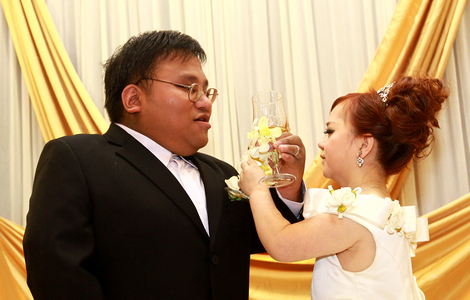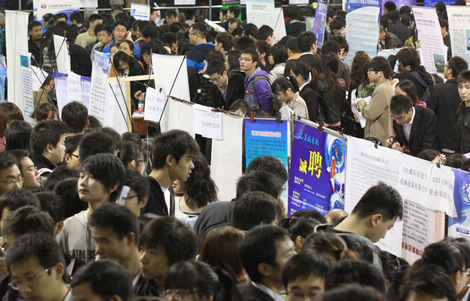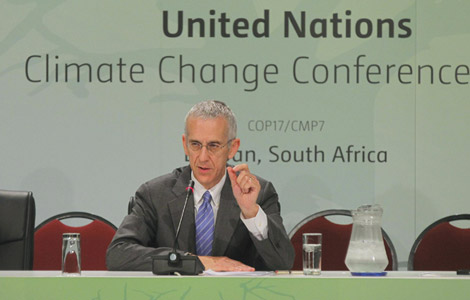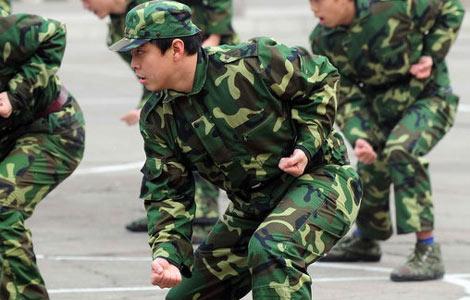Smog spawns environmental awareness in China
Updated: 2011-12-02 22:29
(Xinhua)
|
|||||||||||
BEIJING- As the press has been spilling gallons of ink over the country's air quality issues, a cartoon entitled "I gauge air quality for my motherland" is spreading widely via the Internet.
The cartoon, clearly inspired by the popular poster "I exploit crude oil for my motherland" in the 1960s, portrays two middle-aged men holding up air quality sensors and a young lady with a map in hand, looking serious, sleeves rolled up, against a backdrop of a hazy skyline and floating red flags.
The phrase "for my motherland" has special significance in China. In the 1960s, the newly-founded country was in dire need of crude oil. Thousands of oil workers, motivated by the slogan "I exploit crude oil for my motherland," were devoted to oil exploration.
This time, the phrase has been attached to measuring air quality and is stoking a grassroots campaign to fight air pollution. It has marked a rising level of environmental awareness.
Zhang Xiang, 63, a retired forestry worker, is a member of the Beijing-based Daerwen Nature Quest Agency, first initiator of the air quality testing campaign. Before Daerwen, Zhang had already joined a couple of environmental groups in the capital.
"I used to work in the forest factory along Xiaohinggan Mountains in Northeast China. Excessive logging led to soil erosion, and workers were laid off when there were no trees to cut. I suffered the consequences of environmental destruction," Zhang said, explaining how he became a conservationist.
Zhang is a regular participant of Daerwen's weekly field trip to observe waters in Beijing. Starting May this year, he took part in the group's another activity which required members to keep an air quality log.
At first, the project was aimed at testing the capital's indoor air pollution caused by second-hand smoking. The main pollutant was the now infamous PM2.5, an airborne particulate matter under 2.5 micrometers in size.
"I had no idea of what PM2.5 was at that time," Zhang recalled. "After some training, though, I sort of understood."
When Zhang strolled around the Fourth Ring Road near his home in late October, measuring air with the portable testing kit he borrowed from Daerwen, a thick and pungent smog had shrouded the city for days. It was this period that ignited a heated online discussion over air quality.
From celebrities such as real estate tycoon Pan Shiyi, former head of Google China Lee Kai-Fu and noted writer Zheng Yuanjie, to ordinary Internet users, it seemed almost everyone was talking about the polluted air and a discrepancy between the US embassy's measurements and data released by the capital's environmental watchdog.
As grey smog blanketed the city, the US Embassy to Beijing rated the air as "hazardous," whereas the Beijing Municipal Environmental Protection Bureau said the pollution was "slight."
It was later discovered that the discrepancy resulted from different air pollution standards adopted by the two countries.
China doesn't include PM2.5 in its air rating standard, despite it being the major cause for choking smog. The United States does.
PM2.5, once hardly heard scientific jargon, became a buzzword overnight.
Meanwhile, more and more people are taking it upon themselves to judge the air quality.
According to Wang Qiuxia, a project manager at Daerwen, there used to be 20 plus volunteers for the air quality testing project. The number has surged to over 60 since autumn. Most volunteers are white collar workers, with a few college students, retirees and primary school pupils.
Similar air-monitoring activities, either organized by environmental groups or self-motivated individuals, have been springing up in places outside of Beijing.
In the capital city of central Hunan province, the local environmental group Green Xiaoxiang launched a campaign this month called "I gauge air quality for Changsha."
Residents in major cities like Shanghai, Guangzhou, Nanjing and Jinan have rushed to post photos of polluted skies on their microblogs.
The burgeoning nationwide campaign seemed to prompt government action.
On Nov 17, the Ministry of Environmental Protection began soliciting public feedback on the draft of the revised Environmental Air Quality Standards, which includes the measurement of PM 2.5 and ozone density.
The ministry said the new standards will be fully implemented in 2016, adding that local governments are encouraged to implement it earlier.
In the growing public debate over air quality, Du Shaozhong, deputy head of Beijing's environmental watchdog, is in the spotlight. Over the past month, he has faced a flurry of questions and criticism regarding air quality from Internet users.
Du said the grassroots campaign and ongoing public discussion are indications of China's rising environmental awareness.
Before the Beijing Olympics in 2008, no such large-scale discussion had ever occurred, Du recalled.
Wang Qiuxia agrees with Du on this. Since its establishment in 2009, Daerwen has never had more people volunteering, she said.
"As an environmental NGO we want to attain a set of goals. As for the aim of raising the public awareness, I think we have succeeded," Wang said.
She noted that many people, though interested, did not have much knowledge about the environment, nor about what they can do to protect it.
Du also thinks much work needs to be done on environmental education, citing the recent discussion in which some Internet users misunderstood PM2.5.
He added that the government should motivate the public and make their participation more vigorous.
"Without the public's effort, environmental protection will be just vain talk," Du said.
Hot Topics
HIV/AIDS, Egypt protest, Thanksgiving, climate change, global economic recovery, home prices, high-speed railways, school bus safety, Libya situation, Weekly photos
Editor's Picks

|

|

|

|

|

|







